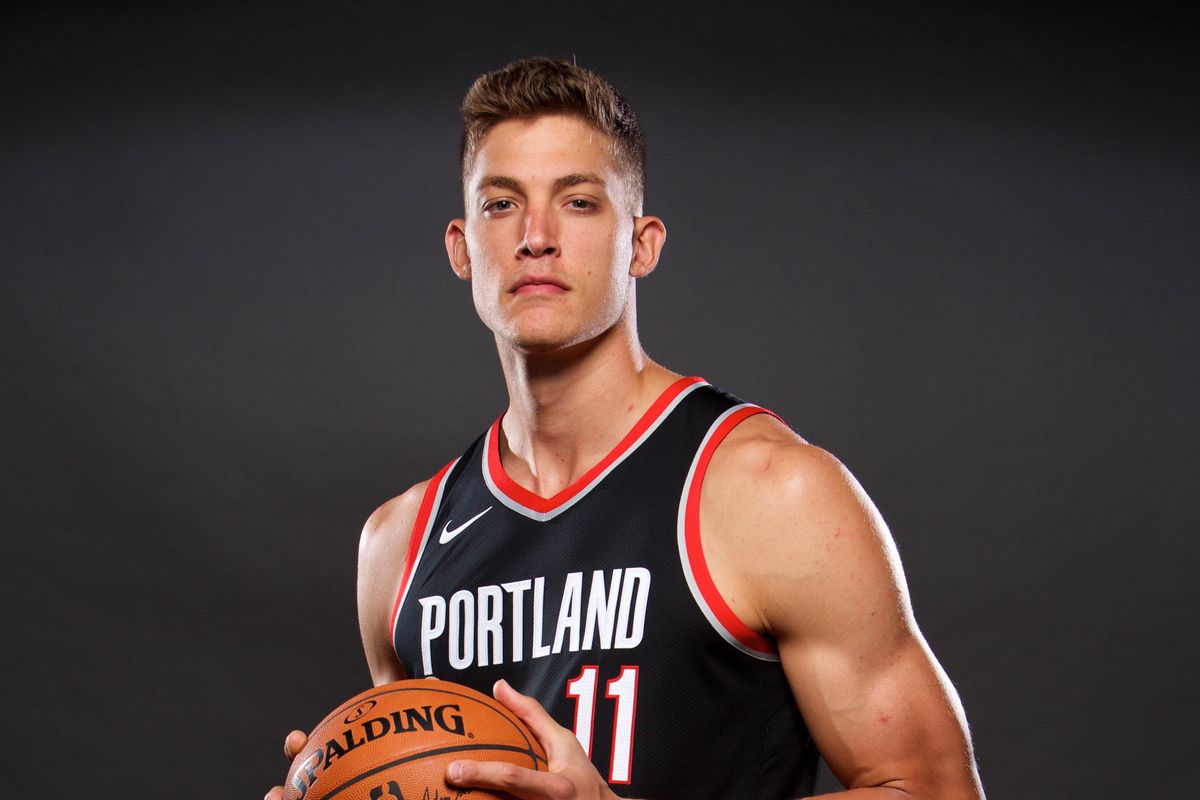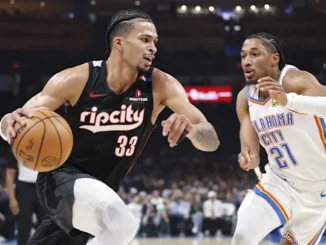
Meyers Leonard and Portland have had a tumultuous relationship over the last seven years. Selected in the same draft as Damian Lillard, Leonard, out of Illinois, was the 11th overall pick in 2012. With the physique of a Greek God and familiarity of one of your close family members, expectations for Meyers were set high with the assumption that he and Lillard would be the start of a young core to usher the team into the modern league.
The first four years of Leonard proved that not all lottery picks are guaranteed; it wouldn’t be the first time Portland saw a young prospect’s production not reflect his draft spot. But that’s the name of the lottery game—you don’t know who the future All-Stars are while they’re exiting their teenage years.
It was difficult to see our guy only average 5.6 points in those first four seasons, but his rookie contract was palatable. That, and Meyers-the-human was a positive presence on the team, always the first to cheer on his teammates and the last one to ever express if he was remotely unsatisfied with his role.
Seeing how much he loved his brother in pre-draft coverage—a surprise return from him while he was serving in Afghanistan—showed me that Meyers would never be a disappointment. After years of worrying about which player would be on the police report in the Jail Blazers era, Meyers was redemption and stability.
However, during summer 2016 and with the salary-cap spike that ensued, the mood in Portland shifted, and unfortunately, Meyers was one of the biggest targets of a disgruntled fan base.
Skyrocketing from $70 million to $94 million, the salary cap increase gave the go-ahead for so many teams to lock down players with hearty contracts and encourage incumbents to stay with the team that had their bird rights.
But not all of the contracts given out that summer were necessarily appropriate for the player’s skill levels. Notable contracts that made us all go, “Him? Really?” were Bismack Biyombo and Joakim Noah for 4 years for $72 million, Tyler Johnson for 4 years at $50 million, Nicolas Batum at $120 million and 5 years, and Timofey Mozgov for 4 years at $64 million. General Managers were handing out contracts like they had to spend the money or lose it, and by the Blazers best luck, Neil Olshley gave us multiple questionable contracts that would haunt us for years to come.
Along with Evan Turner’s 4 years, $70 million and Allen Crabbe’s 4 years, $75 million, Meyers was offered 4 years, $41 million. It wasn’t the worst in a year where the league went on an unhealthy shopping spree, but it was concerning enough to make Blazers fans question Olshley’s decision making once again—and enough for fans to reach their hilt on November 30th, 2017.
After signing his 2016 contract, Meyers’ minutes and stats were sporadic at best. Sinking to a career-low 7.7 minutes played in 2017-18, Meyers checked in that night on November 30, only to be met with boos from the Rip City crowd after air-balling a three-pointer. Dame and Meyers easily brushed it off as ‘bogus’ at the time, but earlier this year, Meyers was honest about the toll it took on his mental health:
“I was depressed, I had anxiety pulling up to our arena, I mean it was bad. I didn’t want to go in public for fearing what people thought of me…”
And who could blame him? Can you imagine walking into the place you work and everyone in the vicinity booing you when you try to do your best? That would be rough on any human, let alone a professional athlete with all the pressure in the world on them.
That night felt like a wake-up call and a turning point for the fans’ relationship with Leonard. He didn’t come in and miraculously drop 30 and redeem himself—he just soldiered on.
Like he told his brother, “tears happen.” It was not fixed overnight or even within the season. But facing the articles the next morning about our wack fanbase made some Blazers fans reevaluate booing one of their own players—including myself. I had been one of Leonard’s toughest critics, but I felt ashamed of how I had talked about him in the last couple of years. I don’t think I was alone.
I can’t say when the exact game was or even what play spurred it. But one night when Meyers checked in and found his rhythm, I don’t think I’ve ever heard the Rose Quarter as loud as it was that night. It wasn’t sarcastic and it wasn’t for our own personal redemption. We were cheering for our guy and no one else’s. Meyers was ours, for better or for worse, and we finally accepted it.
Meyers is still the first teammate off the bench to cheer on his team, and when he is on the court, he is constantly yelling and communicating on the floor for defensive situations. Occasionally the microphones even pick up his booming voice all the way from the sidelines.
His play may be questioned at times, but his camaraderie and attitude are unmatched.
I ask of you, Miami and Pat Riley, please take care of our guys. Meyers will be in Miami next season after Portland’s trade for Hasan Whiteside, a completely different kind of tumultuous player. I can already see Meyers with a tank top on in South Beach, looking like he belongs there—and that’s what stings the most.
I knew his Blazers run would end eventually; this is a business and these things happen. I wasn’t always this fond of him, but now I have the urge to fight anyone who disparages the man.
Meyers, I want to personally say thank you. Thank you for never quitting on us even though we tried to quit on you. Thank you for being you and never wavering in the effort you put into this team. Thank you for letting me scream at a seven-foot bro for the slowest three-point shot I think I’ve ever seen. You will always be our Blazer, but now you have a new team to show how much more you have to give.
I’ll be giving you the standing ovation you deserve from my living room when you return to the Rose City. Give ‘em hell, my guy.




